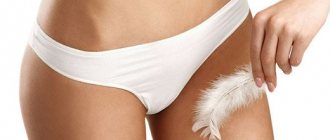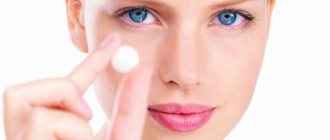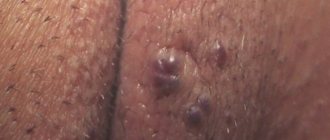Herpes on the lip is one of the most common diseases of viral origin with a high level of virulence, that is, contagiousness. This disease is characterized by the appearance of painful redness, rashes and blisters on the surface of the upper or lower lip.
Herpes can occur with equal frequency in both adults and children. This disease is not only a serious cosmetic defect, but also an external manifestation of pathological processes in the human body. Some time after their appearance, the blisters burst and bleed, and in their place ulcers and erosions form, which can serve as a real “pass” for various pathogens.
Herpes causes serious discomfort in a person, making him feel uncomfortable and insecure when communicating with other people. Women who experience serious difficulties applying makeup and even close communication with their interlocutor feel especially uncomfortable. The two most common questions when you have a “cold” are: how to properly treat herpes on the lips and how can you get rid of herpes on the lips at home? To answer these questions, you must first understand the causes of the disease.
Causes and pathogens of herpes on the lips
Pathogens
Among the types of herpes viruses that cause colds on the lips, there are usually 2 types. These are HSV-1 and HSV-2 (types 1 and 2 of herpes simplex virus). But the reasons for the appearance of herpes on the lip in almost all cases are determined by the presence of a type 1 pathogen. And type 2 HSV mainly affects the genital area, but in rare cases it can cause herpes in the face or lips, usually when the virus is transmitted from the genitals to the face.
The incubation period of herpes on the lips can last up to two weeks, and with primary infection up to one week. The causative agent is a DNA virus.
Causes of primary infection
Nothing depends on how herpes starts. The first infection with herpes can appear not only on the lips. Herpes of the first type can manifest itself in the form of herpetic stomatitis or rashes on the nose, cheeks, forehead and other areas of the face. It can manifest itself in the form of ophthalmoherpes, that is, herpes on the eye in the eyelid area or on the retina. And later, with a relapse, as a rule, it begins to appear in the form of blistering rashes on the lips.
Very often, herpes is transmitted from mother to child. At the same time, up to six months, the titer of antibodies to the herpes virus in the baby’s body has a high level. Therefore, herpes most often begins to appear in children between six months and two years.
The first infection occurs primarily through the following contact interactions:
- through household items, if they were touched by a person who developed herpes in an acute form;
- through touching, for example, a hand affected by herpes to the face or body;
- through a kiss, it’s not for nothing that colds on the lips are called “kissing disease”;
- through utensils, this is a common type of infection among household items;
- through hygiene items, towels and other things used by the patient.
It is necessary to understand that a cold can be transmitted from a person who has no obvious symptoms. Despite the fact that when herpetic sores dry out, herpes is no longer considered so contagious, it can be contagious when it has not yet begun to pop up.
Causes of recurrent herpes on the lips
When herpes appears on the lips, this is often a recurrent stage of herpes. Typically, the manifestation of a cold occurs due to the fact that factors favorable for this appear. It is believed that if the immune system is strong, then herpetic rashes can appear extremely rarely.
Let's look at the factors under which herpes can appear on the lip:
- colds, in which the immune system often suffers;
- taking steroid-containing medications;
- for difficult to tolerate diseases such as hepatitis and others;
- severe thermal changes, especially hypothermia;
- depression, all kinds of stress and fatigue;
- traumatic injuries to the lips or the area near the lips;
- various procedures related to cosmetology and dentistry.
Be aware that if herpes begins to appear in the lip area too often and also lasts a very long time with constant treatment, this may indicate that there are serious problems in the body or complex diseases, in which case consult a doctor immediately.
Features of the course of infection in pregnant women and nursing mothers
A recurrence of the virus in a woman during pregnancy can negatively affect the health of the fetus. It is especially dangerous for the baby if the expectant mother is diagnosed with acute primary herpes. It is believed that in this case the child may become infected during childbirth. But some experts say that even with a cesarean section, there is a risk of neonatal herpes.
Infection with the virus can cause pathologies in the baby’s central nervous system, skin, eyes, and the development of encephalitis. If a relapse is observed in a woman in late pregnancy, this causes spontaneous abortion. According to statistics, herpes infection is considered the second disease after rubella, due to which children with disabilities are born.
As for nursing mothers, they do not have to worry about infecting their baby with the virus during breastfeeding. Some experts argue that it is mother's milk that will protect the baby from further infection. This is explained by the fact that in this way the mother transmits antibodies to the herpes virus to the baby.
Localization of herpes on the lips
Before we get to the symptoms, let's look at what herpes on the lips looks like. Depending on their location, herpetic rashes can appear on both the upper and lower lips, as well as in the corners of the lips; the main thing is not to confuse a herpetic rash with ulcers, because in this case it will be possible to forget about effective treatment.
Photo No. 1 shows the most common location of colds on the lips; most often the development of a rash occurs on the lower lip. In photo No. 2 you can see how the herpes virus, affecting the facial nerve, came out in the corners of the lips.
In photo No. 3 you will see herpes above the upper lip; this is not such a common localization, but no less unpleasant. And photo No. 4 shows herpes under the lip, and a herpes rash can also go down even lower to the chin.
Promoral period
During the promoral period, the places that were characterized by tingling swell. Then small bubbles appear, which are initially transparent, but after a while become cloudy. This process takes no more than 2-3 days.
After which the painful blisters on the lip burst, which indicates the beginning of the next phase of the development of the disease.
Symptoms and signs of herpes on the lips
The symptoms of herpes on the lip have five stages. Thus, it is much easier to understand how advanced the disease is. And also by studying the signs of herpes by stage, it will be easier for you to navigate the chronology of the disease. When it comes to herpes on the lip, the symptoms in other locations are almost similar, if we are dealing with the same types of herpes that are the causative agents of colds on the lip. Namely, their external symptoms on the skin, since symptoms on the mucous membranes may differ.
Let's take a closer look at the stages of herpes on the lips to understand not only how herpes in the lip area manifests itself, but also how it behaves within two weeks.
| Chronology | Description |
First day. | Initial stage. The symptoms of herpes on the lips on the very first day are more of an irritating itching than an external manifestation. Often there is a slight burning sensation with tingling, especially if you touch the affected area. During this period, the herpetic rash is in its most vulnerable stage, so this is the most favorable time to suppress the virus. And it’s better to start treatment as quickly as possible, because the rash can go to the next stage within 6 hours. |
From two to three days. | Stage of inflammation. At this stage, the virus actively spreads in the form of divisions within the affected areas of the skin. At this moment, swelling begins to be visible and individual elements of the skin become noticeably red. The blisters look like a small rash; usually at this stage it is clear that a cold has popped up. |
Four to five days. | Stage of bubble damage. This stage is perhaps the most unpleasant of all the others. Herpetic blisters begin to burst and infect the skin between the spilled elements. This causes all that little rash to turn into one big, wet blister. At the same time, the lymph nodes that are located under the jaws may enlarge and the temperature may rise. |
From five days to eight days. | The stage of transformation of bubbles into crusts. At this stage, the bubble begins to dry out and become like a hard yellow or brown crust. The cold may hurt a little and it seems that the herpes has already passed and is simply healing. But this is not so, the viruses inside the crust are still active and when the surface bursts, they flow out along with the liquid, being quite dangerous for infecting another organism. |
From nine to fourteen days. | Recovery stage. At this stage, it is on the lips, under the crust of the dried herpetic bubble, that a new, pink skin forms. In order for the herpes to heal faster, it is not recommended to touch the crust, much less tear it off, otherwise it will take time for a new dried crust to form. |
Viral pemphigus in the oral cavity
The appearance of watery blisters in the oral cavity may be associated with the development of the so-called “Turkish flu” - viral pemphigus.
This disease is most often recorded in children, which is explained by the immaturity of the immune system.
In adults, it can be practically asymptomatic, which is why patients, not knowing about their status, spread viruses into the environment. Among the possible manifestations of the disease:
- Temperature rise up to 40 °C and above.
- Signs of intoxication, in particular, aches, weakness, headache.
- Sore throat, which is accompanied by the formation of blisters on the mucous membranes of the mouth. Their size most often does not exceed 0.5 cm, they are filled with transparent or bloody contents. The blisters are localized on the palate, tongue and mucous membranes of the cheeks. They quickly burst, leaving behind ulcers.
- A rash on the body (from a couple of blisters to 100 elements), which also has the appearance of blisters. Elements of the rash are found on the palms, soles, and lateral surfaces of the fingers and toes.
The disease is viral in nature and requires only symptomatic treatment. Trying to endure the disease on your feet is fraught with the development of complications.
Diagnostics
It may seem that herpes rashes are easy to diagnose, but this is not entirely true. Indeed, if the rash is already at the stage when everything is clear, then diagnosis is easier, but when a cold just begins to appear on the lips, it can be confused with other diseases. For example, atopic dermatitis on the labial surface is very similar to herpetic rashes, and the bacterial disease impetigo can also be similar to a cold.
When the doctor is not sure that there is a cold on the lips, he resorts to a more professional diagnosis:
- Enzyme-linked immunosorbent assay (ELISA). This method will give an understanding of whether the herpes simplex virus is present in the blood, and whether it will be type 1 or type 2. The ELISA will not show it. The test checks for IgG and IgM antibodies to the herpes virus.
- HSV test. This analysis is used to find out exactly what type of herpes simplex virus it is. In addition, it is also able to determine the presence of a virus in the blood.
- Polymerase chain reaction (PCR). To carry out PCR, it is necessary to take a sample of biomaterial from a known affected area. That is, an analysis of saliva, mucous membrane, etc. is taken. The analysis will show the presence of viral DNA in the sample.
Also, for a more accurate diagnosis, immunofluorescence analysis (IFA) may be needed. For most tests, blood is taken.
Outer
- Herpes - the virus of this disease leads to the formation of blisters filled with liquid of different sizes and locations. Often the blisters appear in groups and are accompanied by hyperemia, itching and slight pain.
- Bubbles can appear not only as a result of illness, but also as a result of accidental injury, which can occur as a result of:
- talking while eating;
- malocclusion;
- contact with acid;
- thermal burns;
- improper installation of dentures.
- Herpes – the virus of this disease leads to the formation of blisters filled with liquid of different sizes and locations. Often, blisters appear in groups and are accompanied by hyperemia, itching and slight pain.
- Blisters can appear as a result of illness, as a result of accidental injury, which can occur as a result of:
Pharmacological treatment of herpes on the lips
Treatment of colds on the lips is most effective using tablets and ointments. Of course, there are many methods and traditional medicine to try to suppress the herpes virus, but this article will only describe traditional methods of drug therapy. Since treating herpes on the lips using home and folk methods is a fairly broad topic.
First, you need to understand that herpes viruses are incurable. At least to date, no medicine has been found to completely cure this problem. Secondly, you need to know that the virus itself can only be treated in an acute form, or, better yet, suppressed. Therefore, you should not try to resort to treatment if, during tests, you learned about the presence of the virus in the body, but at this moment it does not manifest itself in any way.
For a cold on the lip, the following ointments and tablets are used for treatment:
- Viferon ointment. It is used both for lips and for other localizations.
- Gel Fenistil. Often used if there is an allergy to other drugs.
- Acyclovir tablets. Perhaps the most popular remedy for herpes.
- Acyclovir ointment. This ointment effectively treats colds in the first stage.
- Zovirax cream. It acts exactly like Acyclovir and is its analogue.
- Gerpevir ointment. One of the most effective remedies for herpes of various localizations.
Herpes on the lips is also treated with Famvir tablets and Valaciclovir tablets, but they are only available with a doctor's prescription. In general, if treatment for herpes on the lip takes a long time without visible improvements, this may indicate serious problems. It is better not to self-medicate and immediately seek help from a specialist, it will be cheaper and more effective.
Is the infection completely curable?
Herpes remains in the body forever. Stores its genetic material of nerve cells. Here it is inaccessible to antibodies - specific proteins produced by the immune system to protect against pathogenic microbes. When the number of antibodies drops, the virus moves to the skin and mucous membranes, moving along nerve fibers.
To avoid frequent relapses of the virus, you need to follow the rules of personal hygiene and not have a promiscuous sex life.
A good prevention of genital herpes is the following:
- having sex only with a condom;
- treatment of the mucous membranes of the external genitalia with special antiseptics (Miramistin) after each sexual intercourse;
- vaccination. It has been proven that about 74% of vaccinated women did not catch herpes during unprotected sex with a carrier of the virus.
To prevent exacerbation of the disease, a woman needs to lead a healthy lifestyle, eat healthy food, avoid stressful situations and undergo regular preventive examinations with a gynecologist.
Prevention
Herpes on the lips in men and women can sometimes appear more often than in children. This may be due to frequent stress in everyday life. Therefore, if you have a cold on your lip, then after treatment it is advisable to take up the task of maintaining a stable emotional state. The appearance of herpes in the lip area can indicate not only systemic problems, but even improper sleep patterns and insufficient rest.
If the virus often worsens, when a cold constantly appears on the lip, it is recommended to go to the clinic and have your immune system checked. In addition, the fact that herpes has appeared on the lip does not mean that this is a problem exclusively with the immune system, so it is worth taking tests to check for hidden infections of non-herpetic origin.
Almost all preventive methods for preventing the activation of the virus in the body are aimed at stabilizing the immune system. Therefore, in order for herpes on the lip or other places to appear less frequently, it is necessary to support the body by following simple rules of a healthy and active lifestyle.
So, we have examined in detail how a herpetic rash manifests itself in the lip area. To summarize, I would like to note that the herpes virus can sleep in the body for quite a long time, but this does not mean that you should neglect preventive methods and a healthy lifestyle. It may also seem that the activation of the virus can be easily suppressed without visiting a specialist and this will not cause tangible consequences. Be aware that by resorting to the independent use of immunomodulators and antivirals, you are at great risk of getting serious complications.
Complications of herpes infection
Due to sexual herpesvirus, a woman with a weak immune system can seriously damage her internal organs.
The virus also affects the development of pathologies in:
- the vestibule of the vagina or its mucous membrane;
- cervix, cavity and uterine mucosa;
- ovaries, fallopian tubes;
- mucous membrane of the urethra;
- anus, rectal mucosa;
- bladder.
This is the main reason why herpes is dangerous for women. If it affects these organs, the risk of developing several times increases:
- cystitis;
- vaginitis;
- colpitis;
- endocervicitis;
- damage to the anus and rectum.
Experts have proven that a recurrent virus can trigger the development of malignant tumors in the uterine cervix.
Features of nutrition during illness
During illness, doctors recommend avoiding spicy, fried, or too hot foods.
Solid foods can also have a negative effect: they can scratch your lips, lead to irritation and complications.
During illness, it is recommended to consume vegetables, fruits, dairy products, vegetable soups and purees, lean meats and fish. Food should be soft, liquid, filled with vitamins.
Baked goods, seasonings, pickles, sweet carbonated drinks, and too heavy and fatty foods are excluded from the child’s diet.
By following these rules, the child will recover faster.









